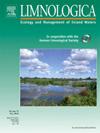Discovery of the Asian clam Corbicula sp. form A in Ensenada, Baja California through conventional taxonomy and innovative shell dna whole genome amplification
IF 2
4区 环境科学与生态学
Q2 LIMNOLOGY
引用次数: 0
Abstract
Ensenada, Baja California is characterized by intermittent runoff occurrences, typically limited to the rainy season, and scarce hot springs, devoid of documented native freshwater clam populations. Notably, the region encompasses the 'Emilio López Zamora' reservoir, vital for water storage and urban supply. However, an unexpected phenomenon unfolded during the dry season of 2021: a substantial accumulation of deceased freshwater clam shells was serendipitously discovered along a stretch of sandy reservoir bed. The goals of this study were to determine the identity of the clam, analyze its possible origin and consider its potential control/use. A sampling of 100 these shells was carried out to perform morphological and molecular identification. Morphological identification was carried out using conventional malacological techniques of taxonomy based on shell morphology. Molecular identification was conducted by extracting DNA from both the shell and periostracum of deceased clams, employing whole-genome amplification (WGA) in conjunction with PCR and sequencing techniques. The integration of classic malacological methods with molecular analysis unequivocally confirmed the lineage of the clam as Corbicula sp. form A. This is the first record of this invasive species in the city of Ensenada, Baja California. The WGA method demonstrated its efficacy in identifying deceased mollusks when only the shell remains, and nucleic acid availability is constrained. The origin of the clam within the reservoir remains elusive, underscoring the need for future investigations to delve into its potential for biomonitoring, bioremediation, and aquaculture applications.
利用传统分类学和创新的壳dna全基因组扩增技术在下加利福尼亚州恩塞纳达发现亚洲蛤Corbicula sp. form A
Ensenada,下加利福尼亚州的特点是间歇性的径流发生,通常仅限于雨季,并且缺乏温泉,缺乏有记录的本地淡水蛤蜊种群。值得注意的是,该地区包括“Emilio López Zamora”水库,对储水和城市供水至关重要。然而,在2021年的旱季,一个意想不到的现象出现了:沿着一段沙质水库床,偶然发现了大量死亡的淡水蛤壳。本研究的目的是确定蛤的身份,分析其可能的来源,并考虑其潜在的控制/利用。对100个壳进行了形态学和分子鉴定。形态学鉴定采用传统的贝壳形态学分类技术。采用全基因组扩增(WGA)技术,结合PCR和测序技术,从死亡蛤壳和骨膜中提取DNA进行分子鉴定。经典的线虫学方法与分子分析相结合,明确地证实了这种蛤的血统是Corbicula sp. form a。这是这种入侵物种在下加利福尼亚州恩塞纳达市的第一次记录。WGA方法在仅保留壳的情况下识别死亡软体动物是有效的,并且核酸的可用性受到限制。水库中蛤蜊的起源仍然难以捉摸,强调需要进一步调查,以深入研究其在生物监测,生物修复和水产养殖应用方面的潜力。
本文章由计算机程序翻译,如有差异,请以英文原文为准。
求助全文
约1分钟内获得全文
求助全文
来源期刊

Limnologica
环境科学-湖沼学
CiteScore
3.70
自引率
5.90%
发文量
64
审稿时长
3 months
期刊介绍:
Limnologica is a primary journal for limnologists, aquatic ecologists, freshwater biologists, restoration ecologists and ecotoxicologists working with freshwater habitats.
 求助内容:
求助内容: 应助结果提醒方式:
应助结果提醒方式:


